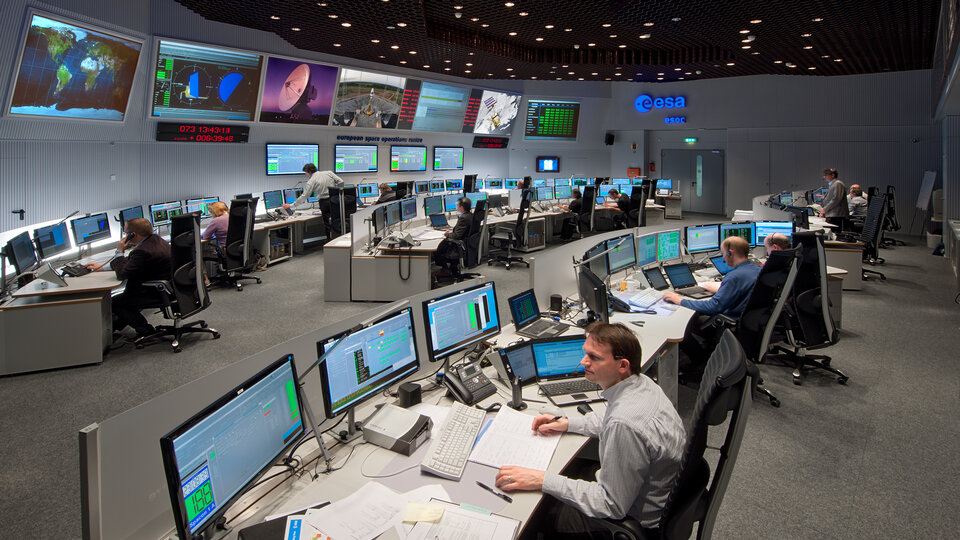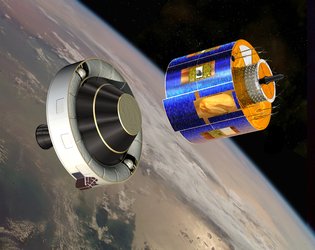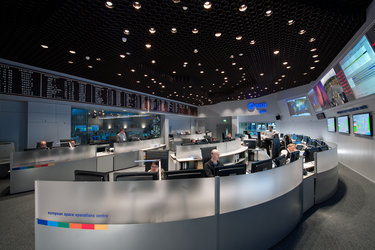MSG-4 launch timeline
On 15 July, a powerful Ariane launcher will loft Europe’s final Meteosat Second Generation weather satellite into orbit from Kourou, French Guiana. For the mission control team at ESA, liftoff will mark the end of months of careful preparations and the start of the mission’s first critical phase.
In a 37-minute window starting at 21:42 GMT (23:42 CEST), Europe’s fourth and final Meteosat Second Generation (MSG) satellite will ride into space on a 55 m-tall Ariane 5 rocket together with co-passenger Star One C4, a telecoms satellite for Embratel. The dual launch had previously been set for 8 July, but was delayed by Arianespace due to last-minute precautionary checks on the rocket and spacecraft.
Once in geostationary orbit above Europe, MSG-4 will ensure data continuity for weather forecasting, and will also play a crucial role in ‘nowcasting’ high-impact weather events and climate research. All four MSGs are operated by Eumetsat – the European Organisation for the Exploitation of Meteorological Satellites – with ESA responsible for their design, development and in-orbit delivery.
This means that a team from ESA’s European Space Operations Centre, ESOC, Darmstadt, Germany, will assume control of MSG-4 immediately after separation and oversee its first 12 days in space – the critical launch and early orbit phase (LEOP) – before handing control over to Eumetsat.
Mission control 24 hours/day

During LEOP, two teams will work on shift in the Main Control Room 24 hours/day, using ESA’s global ground station network to conduct the well-rehearsed operations.
The first passenger, Star One C4, will separate from Ariane’s upper stage 28:15 minutes into flight, followed by MSG-4 at 40:22 minutes.
Separation marks the first occasion that the ESOC mission controllers can start sending telecommands to MSG-4 via the Malindi station in Kenya, performing the initial satellite configuration activities like switching on the attitude sensors.
Thruster burns and spinning up
Starting at about four hours into flight, MSG-4, which is released from the launcher spinning at 5 rpm, will be spun up to 55 rpm, and the satellite will perform a number of slews about its rotational axis to orientate itself correctly. These activities will continue into the second day in orbit.

Starting on 17 July, the satellite will conduct the first of four crucial apogee motor burns, approximately one per day, to circularise its initially highly elliptical orbit. Each burn will last between around 80 seconds and 20 minutes.
Between 22 and 25 July, the protective covers on the camera will be discarded and the satellite will be spun up to its normal rotation of 100 rpm. The camera’s primary mirror will be unlocked and the instrument switched on and decontaminated.
If all goes as planned, by 26 July, the LEOP activities will come to an end with the satellite fully functional and located in its planned geosynchronous orbital slot some 36 000 km above Europe. It will then be handed over to Eumetsat for payload commissioning, preparing MSG-4 to serve as the in-orbit ‘hot backup’ to its three sibling satellites, which were all shepherded into orbit by ESOC.
Watch live
The liftoff will be streamed live from Kourou, starting at 21:27 GMT (23:27 CEST).
Timeline
Timeline below is forecast only and all times are subject to change. Timeline assumes liftoff at start of 37-minute window at 23:42 CEST; times will be shifted accordingly if the liftoff occurs later in the window. See abbreviations at bottom of page. Access an expanded version via ESA’s Rocket Science blog.
15 July 2015
| MET | GMT | CEST | VA224 | MSG-4/ESOC |
| -9:45:00 | 11:57:00 | 13:57:00 | Start of launcher activities on launch pad in Kourou | |
| -9:01:00 | 12:41:00 | 14:41:00 | Satellite switch on to begin (Live telemetry from MSG-4 available after –6:10 MET) | |
| -7:30:00 | 14:12:00 | 16:12:00 | B-Section of Mission Control Team on console in ESOC MCR; start of prelaunch activities in MCR | |
| -6:30:00 | 15:12:00 | 17:12:00 | Start of ESOC network countdown
|
|
| -6:20:00 | 15:22:00 | 17:22:00 | Spacecraft data connection turned ON. This will enable a live cable connection between MSG-4 & ESOC until shortly before liftoff. | ESOC now watching for receipt of telemetry (live onboard status information) from MSG-4 sitting on top of Ariane 5. Signals can be received via data cable or via Kourou tracking station. |
| -6:04:00 | 15:38:00 | 17:38:00 | ESOC now receiving live telemetry from MSG-4 | |
| -5:35:00 | 16:07:00 | 18:07:00 | Ground Operations Manager conducts voice & status checks with all ground stations & Mission Control Team console positions at ESOC | |
| -5:20:00 | 16:22:00 | 18:22:00 | Begin data flow tests on both prime and backup connections between Perth, Malindi & Kourou ground stations and ESOC | |
| -4:50:00 | 16:52:00 | 18:52:00 | Start filling main cryogenic stage with liquid oxygen & hydrogen | |
| -4:05:00 | 17:37:00 | 19:37:00 | Flight Director at ESOC reports ground segment and tracking station status to Kourou | |
| -3:20:00 | 18:22:00 | 20:22:00 | Chilldown of Vulcain main stage engine | |
| -2:00:00 | 19:42:00 | 21:42:00 | A-Section of Mission Control Team on console in ESOC MCR | |
| -1:50:00 | 19:52:00 | 21:52:00 |
Flight Director in Main Control Room at ESOC conducts Go/NoGo roll-call From now on: Mission Control Team continuously checking satellite health & ground systems readiness for launch |
|
| -1:27:00 | 20:15:00 | 22:15:00 | Flight Director in Main Control Room at ESOC reports 'ready' to Kourou | |
| -00:50:00 | 20:52:00 | 22:52:00 | Spacecraft Operations Manager at ESOC briefs ground stations on activities in first pass after MSG-4 separates from Ariane | |
| -00:35:00 | 21:07:00 | 23:07:00 | Flight Director reports ground systems status to Kourou | |
| -00:20:00 | 21:22:00 | 23:22:00 | Arianespace issues final weather briefing | Flight Director reports ground systems status to Kourou |
| -00:11:00 | 21:31:00 | 23:31:00 | MSG-4 now on internal power | |
| -00:07:00 | 21:35:00 | 23:35:00 | All systems Go for launch; start Ariane automated sequence | |
| -00:06:30 | 21:35:30 | 23:35:30 | Flight Director in Main Control Room at ESOC reports status to Kourou (final) | |
| -00:04:00 | 21:38:00 | 23:38:00 | Fuel tanks pressurised for flight | |
| -00:01:00 | 21:41:00 | 23:41:00 | Ariane on internal power | |
| -00:00:04 | 21:41:56 | 23:41:56 | Ariane onboard systems take over | |
| -00:00:03 | 21:41:57 | 23:41:57 | Ariane inertial reference systems switch to flight mode | |
| 00:00:00 | 21:42:00 | 23:42:00 | Ignition of Vulcain - cryogenic main stage engine | |
| 00:00:07 | 21:42:07 | 23:42:07 | Ignition of solid boosters & liftoff | ESA Kourou station starts tracking launcher |
| 00:02:22 | 21:44:22 | 23:44:22 | Solid rocket boosters jettisoned | |
| 00:03:43 | 21:45:43 | 23:45:43 | Fairing jettisoned; Ariane and payload now in space | |
| 00:08:49 | 21:50:49 | 23:50:49 | Main engine cutoff | |
| 00:08:55 | 21:50:55 | 23:50:55 | First stage separation | |
| 00:08:59 | 21:50:59 | 23:50:59 | Second stage ignition | |
| 00:24:00 | 22:06:00 | 00:06:00 | Malindi tracking station: AOS Ariane & AOS MSG-4 (carrier only) | |
| 00:24:48 | 22:06:48 | 00:06:48 | Second stage engine cutoff; injection into orbit | |
| 00:28:15 | 22:10:15 | 00:10:15 | Star One C4 separation | |
| 00:30:56 | 22:12:56 | 00:12:56 | Sylda separation | |
| 00:40:00 | 22:22:00 | 00:22:00 | AOS Perth | |
| 00:40:19 | 22:22:19 | 00:22:19 | MSG-4 separation | MSG-4 now in free flight |
| 00:41:00 | 22:23:00 | 00:23:00 | Mission control team at ESOC starting to uplink first telecommands to MSG-4 via Malindi station; Receipt of commands by MSG-4 confirmed on ground | |
| 01:08:16 | 22:50:16 | 00:50:16 | End of Ariane mission | |
| 04:07:00 | 01:49:00 | 03:49:00 | MSG-4 spun up to 55 rpm | |
| 05:35:00 | 03:17:00 | 05:17:00 | MSG-4 reaches apogee height on Orbit No. 1 (35 794.6 km) |















 Germany
Germany
 Austria
Austria
 Belgium
Belgium
 Denmark
Denmark
 Spain
Spain
 Estonia
Estonia
 Finland
Finland
 France
France
 Greece
Greece
 Hungary
Hungary
 Ireland
Ireland
 Italy
Italy
 Luxembourg
Luxembourg
 Norway
Norway
 The Netherlands
The Netherlands
 Poland
Poland
 Portugal
Portugal
 Czechia
Czechia
 Romania
Romania
 United Kingdom
United Kingdom
 Slovenia
Slovenia
 Sweden
Sweden
 Switzerland
Switzerland




































